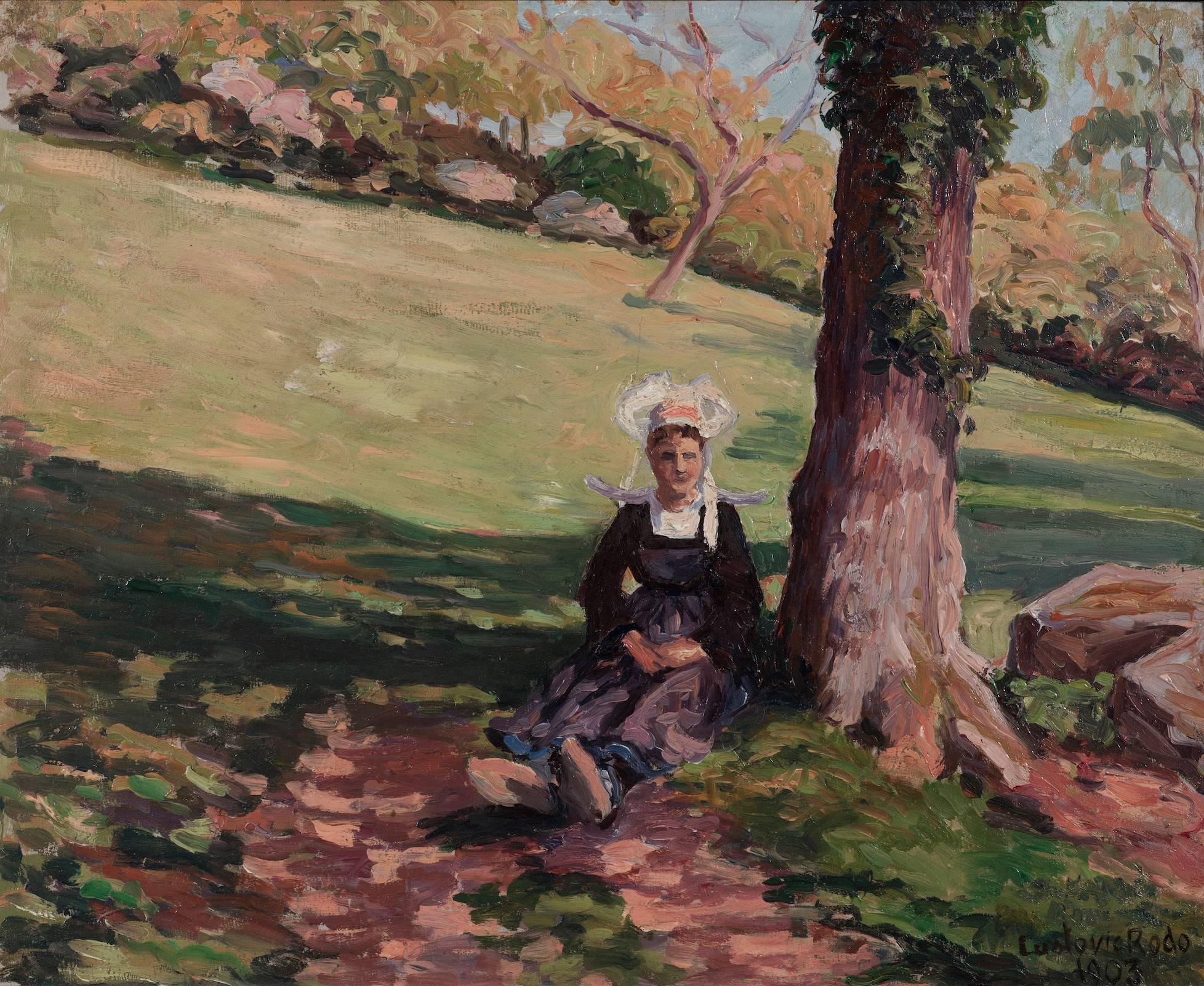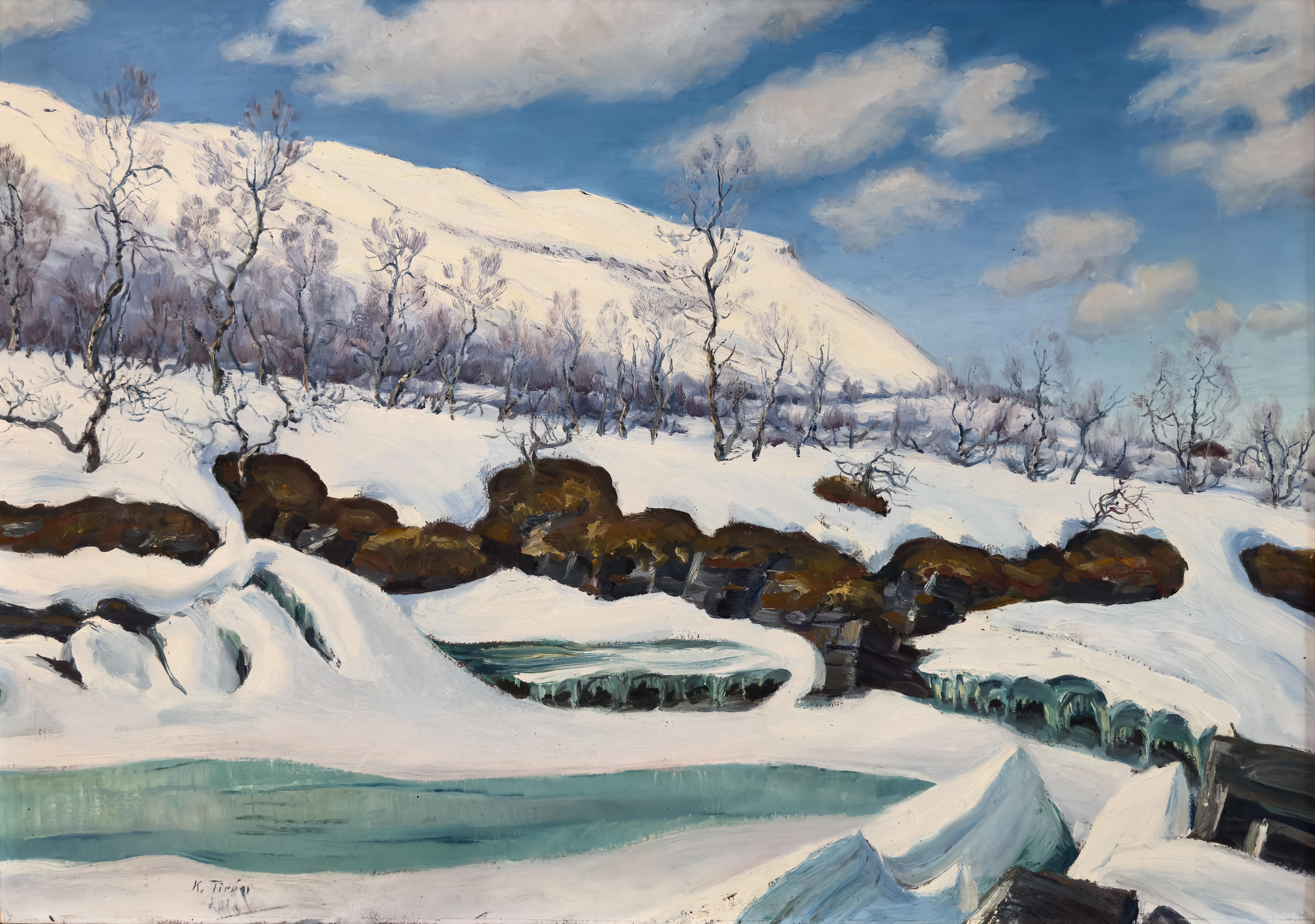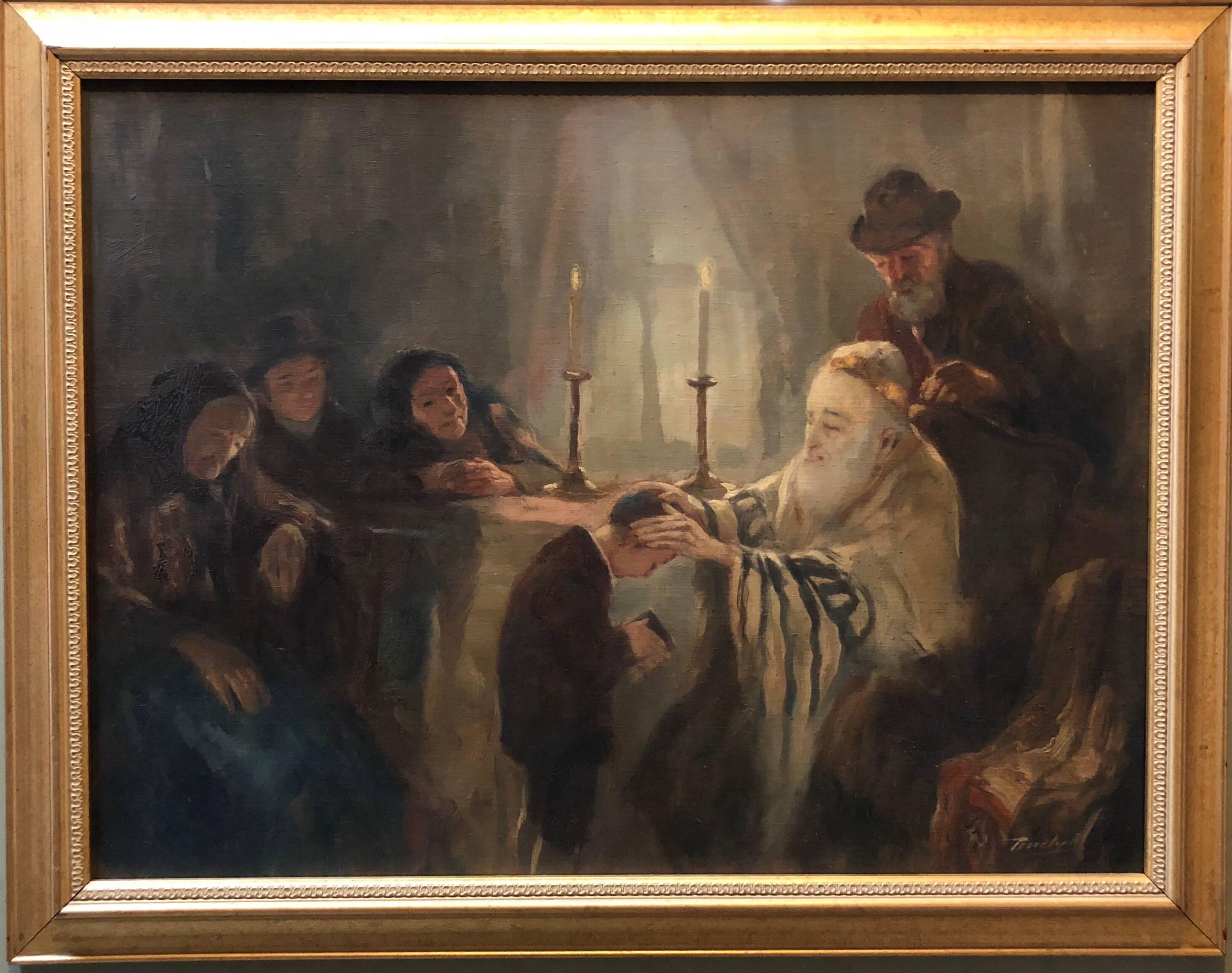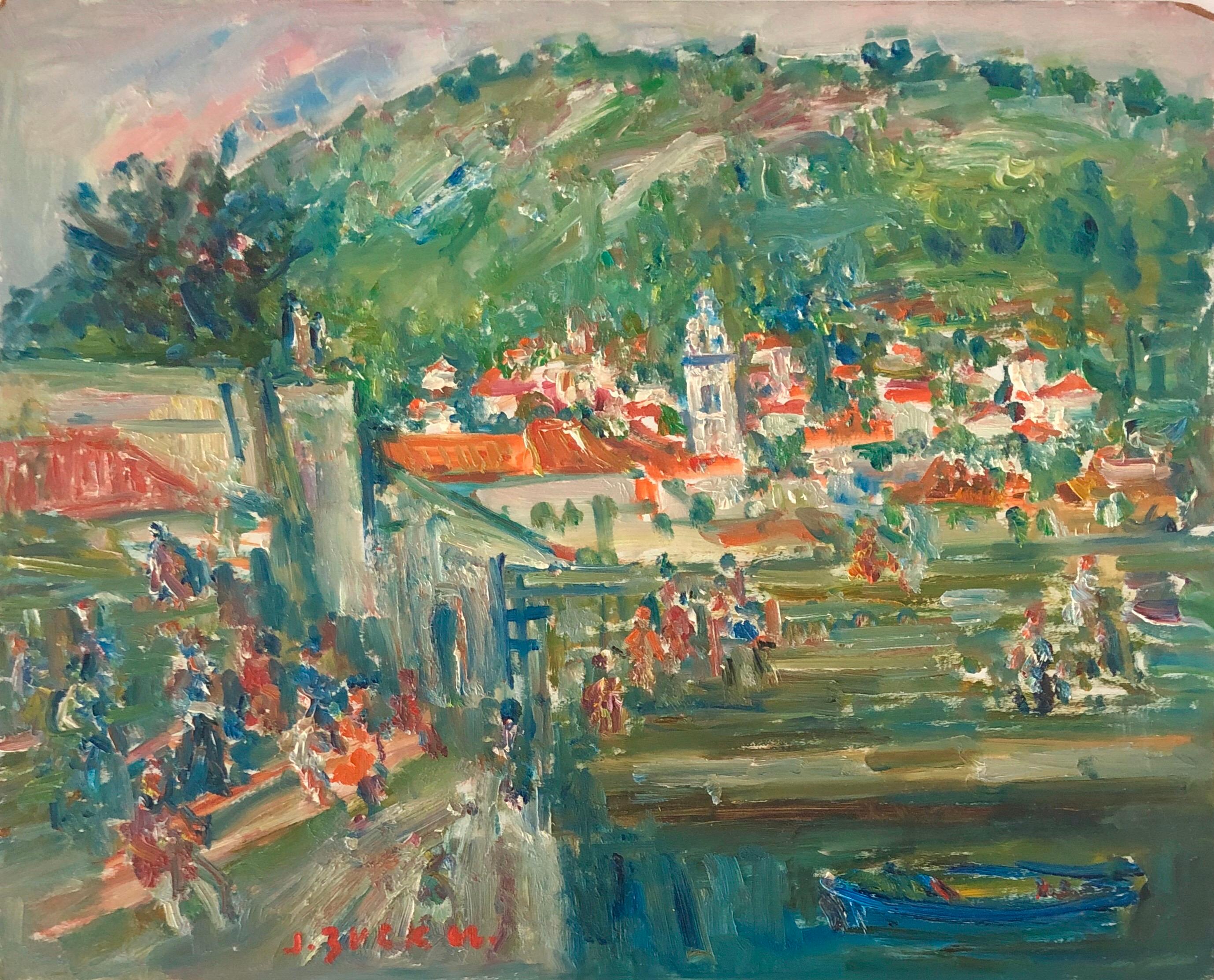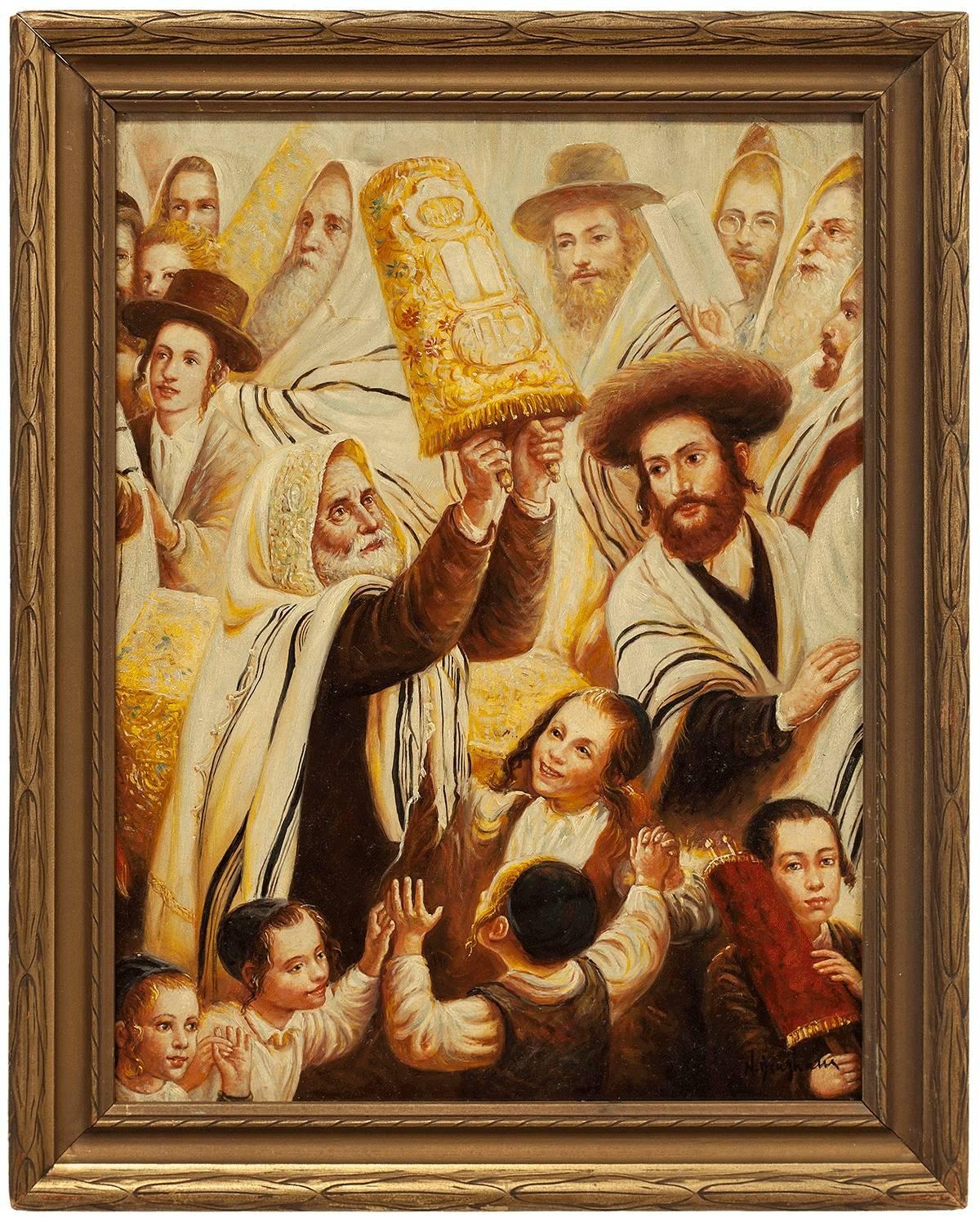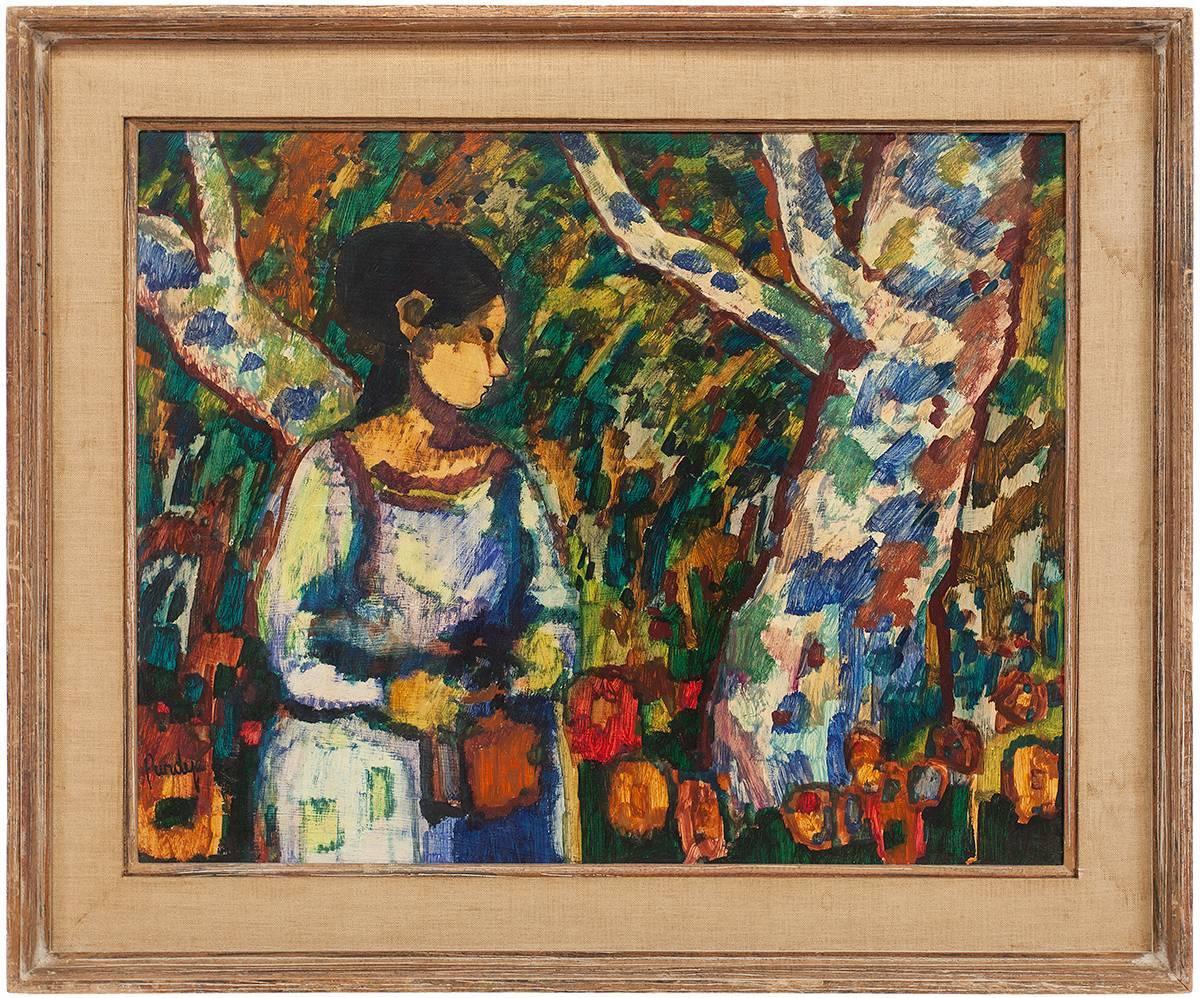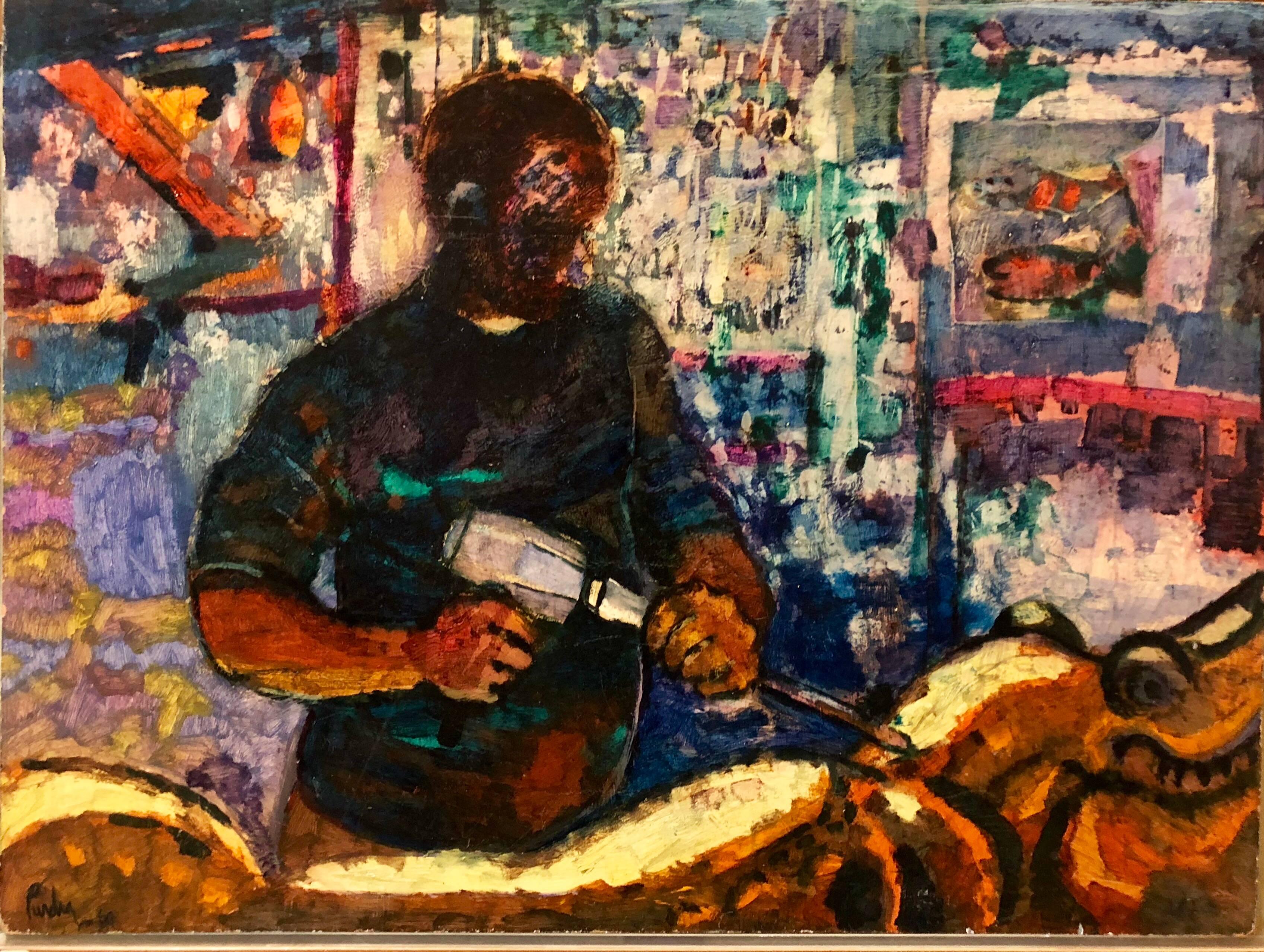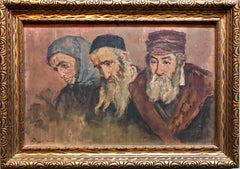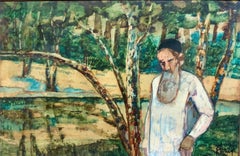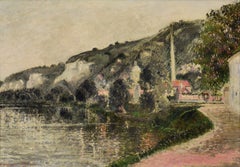
Simchat Torah, Rejoicing with the Torah Jewish Holiday Judaica Painting
View Similar Items
Want more images or videos?
Request additional images or videos from the seller
1 of 6
N. Henry BinghamSimchat Torah, Rejoicing with the Torah Jewish Holiday Judaica Painting
About the Item
- Creator:
- Dimensions:Height: 18.75 in (47.63 cm)Width: 14.75 in (37.47 cm)
- Medium:
- Movement & Style:
- Period:
- Condition:
- Gallery Location:Surfside, FL
- Reference Number:1stDibs: LU3822038623
About the Seller
4.9
Platinum Seller
These expertly vetted sellers are 1stDibs' most experienced sellers and are rated highest by our customers.
Established in 1995
1stDibs seller since 2014
1,553 sales on 1stDibs
Typical response time: 1 hour
More From This SellerView All
- Rare Russian Judaica Oil Painting Jewish Pogrom Refugees Signed in CyrillicLocated in Surfside, FLIn the tradition of the Jewish European artists of the 19th and early 20th centuries, such as Moritz Oppenheim, Max Liebermann, Lesser Ury, Jakob Steinhardt, Jehudo Epstein, Stanislaus Bender...Category
Early 20th Century Post-Impressionist Figurative Paintings
MaterialsOil, Board
- Judaica Meditative Rabbi at Prayer in Nature, Large Landscape Oil PaintingBy Donald Roy PurdyLocated in Surfside, FLGenre: Modern Subject: Jewish Elder , Judaic Prayer Surface: Board Country: United States signed lower left Donald Roy Purdy is an American painter whose work evolved through a rang...Category
20th Century Fauvist Figurative Paintings
MaterialsOil, Board
- Wisdom of King Solomon Rare Biblical Hungarian Judaica Oil PaintingBy Anton PeczelyLocated in Surfside, FLRare Pre World War II (Pre Holocaust) Judaica Art. European Judaic art from this period is exceedingly rare. Péczely Antal Anton 1891 - 1963 Known for his Jewish genre scenes, Chess scenes and other early 20th Century salon style paintings. In the tradition of Moritz Oppenheim...Category
Early 20th Century Post-Impressionist Figurative Paintings
MaterialsOil, Board
- Blessing of the Tzadik (Rebbe) Rare Hungarian Judaica Oil PaintingBy Anton PeczelyLocated in Surfside, FLRare Pre World War II (Pre Holocaust) Judaica Art. European Judaic art from this period is exceedingly rare. Péczely Antal Anton 1891 - 1963 Known for his Jewish genre scenes, Chess scenes and other early 20th Century salon style paintings. In the tradition of Moritz Oppenheim...Category
Early 20th Century Post-Impressionist Figurative Paintings
MaterialsOil, Board
- Modernist Rabbi Oil Painting Judaica Jewish Synagogue Scene Paris. Lichtenstein.By Isaac Lichtenstein 1Located in Surfside, FLFramed 26 x 13 image 20 x 6.5 inches. YITSKHOK LIKHTENSHTEYN (ISAAC LICHTENSTEIN) (1888-1981) (Icchok, Izrael) was born in Lodz, Poland. Initially he was studying at Yehuda Pen school in Witebsk. In the same school where young Marc Chagall started to paint his shtetl Jews, Jewish neighbourhoods and personages. As many young Jewish children who decided painting to be their passion Isaac moved to Paris where he was one of the co-founders of Machmadim - a group of Jewish artists (mostly émigré from Eastern Europe) who dedicated their art to traditional Jewish themes. Later Isaac Lichtenstein studied with Boris Schatz and painted at Bezalel, Jerusalem. Until age seven he was raised in Warsaw; later, when his father received a position with Poznański, he lived with his parents in Lodz. There he studied in a state public school. He demonstrated talent for painting while still quite young, and in 1906 he began to attend the Cracow art academy, before going on to study painting in Rome, Florence, and Munich. In 1908 he entered the Bezalel Art School in Jerusalem. In 1910 he returned to Cracow, lived for a short time in Munich, 1911 in Paris, 1912-1913 again in the land of Israel, and in 1914 he returned to Paris, that very year setting off for the United States. He lived in New York during WWI, where he became part of Jewish literary and artistic circles, and contributed as a graphic artist to a variety of Jewish publications, among them: M. Basin’s Antologye (Anthology), the collection Velt ayn, velt oys (World in, world out), and designed frontispieces, little vignettes, and letters for Yiddish-language books. In 1916 he also began to write and published articles on the plastic arts in: Tsukunft (Future) in New York; the collection Shriften (Writings), vol. 6; Onheyb (Beginning), edited by Z. Vaynper; Morgn-zhurnal (Morning journal); Der amerikaner (The American); Forverts (Forward); and Di tsayt (The times). He did journalistic work also for M. F. Seidman’s correspondence bureau in New York. In 1918 he departed with the Jewish Legion for Israel. In 1920 he came to London, was demobilized there, and was a contributor to the journal Renesans (Renaissance), edited by Leo Kenig, and to the daily newspaper Di tsayt, edited by Morris Meyer. In 1924 he returned to Poland, exhibited his drawings in Warsaw, Lodz, Vilna, and other cities, gave speeches on art (general and Jewish), and published work in: Haynt (Today), Moment (Moment), Folkstsaytung (People’s newspaper), and Literarishe bleter (Literary leaves)—in Warsaw; Unzer lebn (Our life) in Grodno; Voliner lebn (Volhynia life); Nayer folksblat (New people’s newspaper) in Lodz; and elsewhere. He also published impressions from his travels and memoirs of the Jewish Legion in Haynt. He was part of the loose association of émigré artists known collectively as the École de Paris, the majority (among them Marc Chagall, Isaac Dobrinksy, Henri Epstein...Category
Early 20th Century Post-Impressionist Figurative Paintings
MaterialsOil, Board
- French Riviera Harbor Scene Oil Painting Ecole D'Paris, WPA, Bezalel ArtistBy Jacques ZuckerLocated in Surfside, FLGenre: Post Impressionist Subject: Landscape Medium: Oil Surface: board Country: France Dimensions: 13" x 16" Jacques Zucker was born in 1900 in Radom, Poland. He was a notably famous Jewish American artist mostly known for his expressionist figure paintings. In his young years he traveled to Palestine to study fine arts at the Bezalel Art School in Jerusalem. In 1917 he joined the British Royal Fuesiliers under the leadership of General Allenby to liberate Palestine from the Turks. After the first World War he settled in Paris, where he continued his studies at Académie Julian and Academie Colarossi. He then emigrated to the United States in 1922 and continued his art studies at the National Academy of Design. He supported himself by designing jewelry. In 1925 he returned to Paris and studied at the Academie de la Grande Chaumier et Colarossi. During the Depression he worked for the WPA. From 1928 he took part in the Paris Salons: Autumn and the Tuileries. His works are expressionistic variations in the type of the Ecole de Paris. As a protégé of both Chaim Soutine and Renoir, hints of their style can be observed in much of his own work. Zucker’s style, that may have been influenced from the art of artists such as Marc Chagall, took pride in being an “internationalist”, standing the art of painting in its highest expression is universal no matter where the canvas was created. People who respond to quality in art will understand the beauty and meaning, in their own land or in a foreign land, this was his main idea behind his artworks that was exhibited in numerous solo show in leading galleries and museums in New York, Paris, Tel Aviv, and other art centers. Claude Roger-Marx of Figaro Litteraire, dean of French art critics, write a comprehensive study of Zucker’s illustrated with 135 color and black and white plates. He traveled widely, including Italy, Spain, Portugal, Mexico and Israel. From then on Zucker lived alternately in New York and Paris, maintaining homes in both places, and spent considerable time painting in Mexico, Portugal, Greece, and Israel. Zucker's post-impressionist works including town and landscapes, still-lives, and portraits, are part of an array of permanent installments in numerous museums and private collections in Tel Aviv, including the Joseph Hirschorn collection in Washington, D. C., the Museum of Modern Art in Paris, and the Bezalel Art Museum in Jerusalem. In 1947 he settled in Arcueil near Paris. Zucker died in 1981 in New York. The School of Paris, Ecole de Paris, was not a single art movement or institution, but refers to the importance of Paris as a center of Western art in the early decades of the 20th century. Between 1900 and 1940 the city drew artists from all over the world and became a centre for artistic activity. School of Paris was used to describe this loose community, particularly of non-French artists, centered in the cafes, salons and shared workspaces and galleries of Montparnasse. Before World War I, a group of expatriates in Paris created art in the styles of Post-Impressionism, Cubism and Fauvism. The group included artists like Pablo Picasso, Marc Chagall, Amedeo Modigliani and Piet Mondrian. Associated French artists included Pierre Bonnard, Henri Matisse, Jean Metzinger and Albert Gleizes. The term "School of Paris" was used in 1925 by André Warnod to refer to the many foreign-born artists who had migrated to Paris. The term soon gained currency, often as a derogatory label by critics who saw the foreign artists—many of whom were Jewish—as a threat to the purity of French art. Art critic Louis Vauxcelles, noted for coining the terms "Fauvism" and "Cubism", Waldemar George, himself a French Jew, in 1931 lamented that the School of Paris name "allows any artist to pretend he is French. it refers to French tradition but instead annihilates it. The artists working in Paris between World War I and World War II experimented with various styles including Cubism, Orphism, Surrealism and Dada. Foreign and French artists working in Paris included Jean Arp, Joan Miro, Constantin Brancusi, Raoul Dufy, Tsuguharu Foujita, artists from Belarus like Michel Kikoine, Pinchus Kremegne, and Jacques Lipchitz, the Polish artist Marek Szwarc and others such as Russian-born prince Alexis Arapoff. A significant subset, the Jewish artists, came to be known as the Jewish School of Paris or the School of Montparnasse. The core members were almost all Jews, and the resentment expressed toward them by French critics in the 1930s was unquestionably fueled by anti-Semitism. Jewish members of the group included Emmanuel Mané-Katz, Chaim Soutine, Adolphe Féder, Chagall, Moïse Kisling, Maxa Nordau and Shimshon Holzman...Category
Mid-20th Century Post-Impressionist Landscape Paintings
MaterialsBoard, Oil
You May Also Like
- Bretonne sous un Arbre by LUDOVIC RODO PISSARRO - Post Impressionist paintingBy Ludovic-Rodo PissarroLocated in London, GBBretonne sous un Arbre by LUDOVIC-RODO PISSARRO (1878 - 1952) Oil on board 33 x 41 cm (13 x 16 ⅛ inches) Signed and dated lower right, Ludovic Rodo 1903 Provenance Private Collecti...Category
Early 1900s Post-Impressionist Figurative Paintings
MaterialsBoard, Oil
- Brume et Soleil du Matin (The Seine at Les Andelys) by Georges Manzana PissarroBy Georges Henri Manzana PissarroLocated in London, GB*UK BUYERS WILL PAY AN ADDITIONAL 20% VAT ON TOP OF THE ABOVE PRICE Brume et Soleil du Matin (The Seine at Les Andelys) Oil on board 38 x 54.8 cm (15 x 21 ⅝ inches) Signed lower le...Category
1920s Post-Impressionist Figurative Paintings
MaterialsOil, Board
- Vårvinter II (Winter, Early Spring II), Oil on Board, C. 1909Located in Stockholm, SEThe painting "Vårvinter II," believed to have been painted around 1909 by the Swedish artist Karl Tirén, is a remarkable representation of a landscape in the cusp of the seasonal tra...Category
Early 1900s Post-Impressionist Landscape Paintings
MaterialsBoard, Oil
- At cafe 1950, cardboard, oil, 51x71 cmLocated in Riga, LVAt cafe 1950, cardboard, oil, 51x71 cm The main focus of the artwork is a stylized representation of a cafe scene. The artist's intention is to capture the vibrant and lively atmosphere of a bustling cafe setting. The painting features numerous figures dancing in the background, creating a sense of movement and excitement. The artist's stylized approach involves using bold and expressive brushstrokes, vibrant colors, and abstracted forms to depict the figures and the overall energy of the scene. In the foreground, there is a man sitting behind a table with wine bottles, adding a focal point to the composition. The red interior of the cafe provides a warm and inviting ambiance, adding to the overall atmosphere of the painting. Biruta Baumane...Category
1950s Fauvist Figurative Paintings
MaterialsCardboard, Oil
- Early 20th Century oil painting of a London street with a rag and bone manLocated in Petworth, West SussexStephen Bone (British, 1904-1958) A London rag and bone man Oil on board Signed `Stephen Bone’ (on an old label on the reverse) 10 x 13.3/4 in. (25.3 x 35...Category
20th Century Post-Impressionist Figurative Paintings
MaterialsOil, Board
- Toits Rouges à Menton by Georges Manzana Pissarro - Landscape oil paintingBy Georges Henri Manzana PissarroLocated in London, GB*UK BUYERS WILL PAY AN ADDITIONAL 20% VAT ON TOP OF THE ABOVE PRICE Toits Rouges à Menton by Georges Manzana Pissarro (1871-1961) Oil on board 40 x 56.5 cm (15 ¾ x 21 ⅞ inches) Sign...Category
1950s Post-Impressionist Figurative Paintings
MaterialsOil, Board
Recently Viewed
View AllMore Ways To Browse
Wall Mural Figurative
Narcissus Oil
Artisan Yugoslavia
Kid Garland
Mid Century Gold Italian Painting
By Mark Beard
Polish Biennale Poster
Red Dress Paris Painting
French 1600 Painting
Cat Katzen
Wooden Painted Train
Jesus Face Drawing
Louisiane Saint Fleurant
Anne Mei Poppe
Antique Oil Painting James Poole
Jean Marcel Cosson
John Hoover
Peggy Hopper
